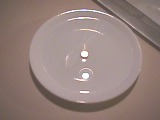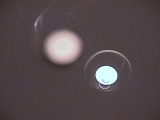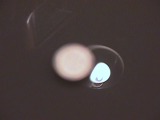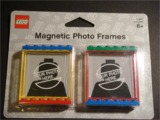


Magnet basics
What is magnetism?
What is a magnet?
A magnet is an object made of certain materials which create a magnetic field. Every magnet has at least one north pole and one south pole. By convention, we say that the magnetic field lines leave the North end of a magnet and enter the South end of a magnet. This is an example of a magnetic dipole ("di" means two, thus two poles). If you take a bar magnet and break it into two pieces, each piece will again have a North pole and a South pole. If you take one of those pieces and break it into two, each of the smaller pieces will have a North pole and a South pole. No matter how small the pieces of the magnet become, each piece will have a North pole and a South pole. It has not been shown to be possible to end up with a single North pole or a single South pole which is a monopole ("mono" means one or single, thus one pole).
History
The ancient Greeks and Chinese discovered
that certain rare stones, called lodestones, were naturally magnetized.
These stones could attract small pieces of iron in a magical way, and were found
to always point in the same direction when allowed to swing freely suspended by
a piece of string. The name comes from Magnesia, a district in Thessaly,
Greece.
Several scientists from the 1600s to today have greatly increased our
understanding of magnets and their properties. Be sure to check:
http://www.worldwideschool.org/library/books/hst/biography/FaradayasaDiscoverer/toc.html
http://www.ee.umd.edu/~taylor/frame1.htm
http://www-istp.gsfc.nasa.gov/Education/whmfield.html
Ferromagnetism
When a ferromagnetic material is placed near a magnet, it will be attracted toward the region of greater magnetic field. This is what we are most familiar with when our magnet picks up a bunch of paperclips. Iron, cobalt, nickel, gadolinium, dysprosium and alloys containing these elements exhibit ferromagnetism because of the way the electron spins within one atom interact with those of nearby atoms. They will align themselves, creating magnetic domains forming a temporary magnet. If a piece of iron is placed within a strong magnetic field, the domains in line with the field will grow in size as the domains perpendicular to the field will shrink in size.
Diamagnetism ![]()
When a diamagnetic material is placed near a magnet, it will be repelled from the region of greater magnetic field, just opposite to a ferromagnetic material. It is exhibited by all common materials, but is very weak. People and frogs are diamagnetic. An interesting experiment showing this is where a frog is levitated at the top of a very strong electromagnet. Metals such as bismuth, copper, gold, silver and lead, as well as many nonmetals such as graphite, water and most organic compounds are diamagnetic.



For example, here are some photos of a very
strong neodymium-iron-boron magnet sitting in a dish with a shallow amount of
water covering the magnet. Looking at the reflection of the light above
the sink off of the surface of the water, you can see how the reflection is
distorted because the water is concave just above the magnet, and flat
everywhere else. (The fuzzy object in the two photos on the right is the
magnet; the camera is focused on the reflected light.) This is because the
magnet has pushed the water away since water is repelled by strong magnetic
fields.
Also check http://www.exploratorium.edu/snacks/diamagnetism_www/index.html
Here's a fixture using diamagnetic disks that you
can purchase and experiment with.
Paramagnetism
When a paramagnetic material is placed near a magnet, it will be attracted to the region of greater magnetic field, like a ferromagnetic material. The difference is that the attraction is weak. It is exhibited by materials containing transition elements, rare earth elements and actinide elements. Liquid oxygen and aluminum are examples of paramagnetic materials.
What are magnets used for?
This is a question I'll let you answer. There are hundreds and hundreds of uses which you will discover here at "Magnet Man" and in the links. Yes, some are used to hold the family's schedule and photos onto the refrigerator door, but that is just one use for magnets. Magnets were first put to use to help navigate since they would always point in a North / South direction, no matter what the weather was. Daniel Boone once said, "I can't say I was ever lost, but I was bewildered once for three days." Perhaps if he had a compass, his bewilderment would have only lasted a few hours!
For the most part, magnets are used to hold, separate, control, convey and elevate products and to convert electrical energy into mechanical energy or convert mechanical energy into electrical energy.
Some more unusual uses for magnetics are:
refrigeration (see also
Patent
#4107935)
bending an electron beam or proton beam in a synchrotron
 Magnets
used to hold photos.
Magnets
used to hold photos.  A shop in Downtown Disney full of magnets!
A shop in Downtown Disney full of magnets!
Here's a list of things I've found around the house and in the car that uses magnets or electromagnets to make them work:
Around the house:
Headphones
Stereo speakers
Computer speakers
Telephone receivers
Phone ringers
Microwave tubes
Doorbell ringer solenoid
Refrigerator magnets to hold things
Seal around refrigerator door
Plug-in battery eliminators
Floppy disk recording and reading head
Audio tape recording and playback head
Video tape recording and playback head
Credit card magnetic strip
TV deflection coil
TV degaussing coil
Computer monitor deflection coil
Computer hard drive recording and reading head
Dishwasher water valve solenoid
Shower curtain weights / attach to tub
Power supply transformers
Motors for use in:
CD spinner and head positioner
DVD spinner and head positioner
Audio tape transport
VHS tape transport
VHS tape loader
Microwave stirring fans
Kitchen exhaust fans
Garbage disposal motor
Dishwasher
Pump
Timer
Refrigerator
Compressor
Ice maker dumper
Sump pump
Furnace
Blower
Exhaust
Garage door opener
Clothes washer
Pump and agitator
Timer
Clothes dryer
Timer
Drum turner
Bathroom exhaust fan
Electric toothbrush
Ceiling fan
Pager or cell phone vibrator
Clocks (not the wind-up type or LCD type)
Computer
Cooling fans
Floppy disk spinner
CD spinner
DVD spinner
Hard disk spinner
Can opener
Motor
Lid holder magnetThings in the Car:
Starter motor
A/C clutch
Interior fan motor
Electric door locks
Windshield wiper motor
Electric window motor
Side-view mirror adjuster motor
CD player motor
Audio tape player motor
Audio tape recorder and playback heads
Engine speed sensors
Alternator
Starter relay
Windshield washer pump motor
Can you find more?
How to find out more
To learn more about magnets and magnetism, you should spend some time reading articles about magnets in encyclopedias at home or on the web, other related websites and other books. When looking for articles, here are some suggestions for keywords you can use in a search (these are linked to Wikipedia):
Three articles with a good review of magnets:
magnet_story01.pdf
magnet_story02.pdf
magnet_story03.pdf
Type one of the words in the list into the Google box above. This will
take you to several more sites.
You can also check the Encyclopedia
Britannica (you may need to become a member to access complete
articles).